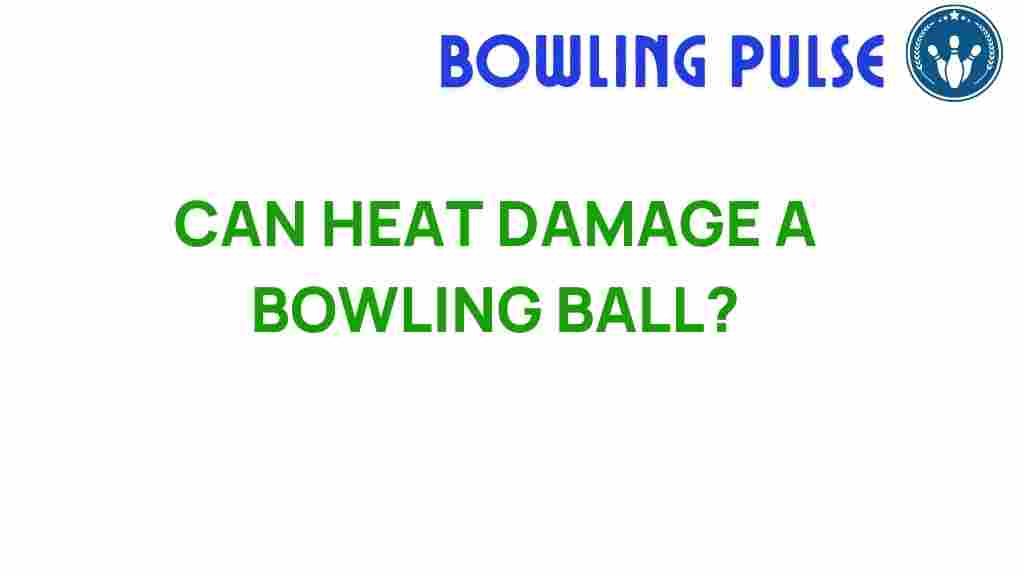The Hidden Dangers: Can Heat Damage Your Bowling Ball?
Bowling is a beloved sport, enjoyed by enthusiasts of all skill levels. However, many bowlers are unaware of the potential hazards that can affect their equipment, particularly heat damage. Understanding how heat can impact your bowling ball is essential for maintaining its performance and longevity. In this article, we will explore the dangers of heat damage, provide maintenance tips, and offer bowling tips to help you protect your investment.
Understanding Heat Damage to Your Bowling Ball
Bowling balls are crafted from various materials, including plastic, urethane, and reactive resin. Each of these materials has unique properties that can be adversely affected by high temperatures. Heat damage can manifest in several ways, including:
- Softening of the Coverstock: Excessive heat can cause the coverstock of your bowling ball to soften, leading to decreased performance.
- Loss of Grip: A softened coverstock can result in a loss of grip, affecting your ability to throw strikes.
- Deformation: Prolonged exposure to high temperatures can cause the ball to warp or develop cracks.
- Reduced Lifespan: Consistent heat exposure can significantly shorten the lifespan of your bowling ball.
The Temperature Effects on Bowling Balls
Temperature plays a crucial role in the performance of your bowling ball. Here’s how different temperature ranges can affect your equipment:
- Under 60°F (15°C): Bowling balls can become harder, making it difficult to generate the desired hook.
- 60°F to 80°F (15°C to 27°C): This is the ideal temperature range for bowling. The ball maintains its optimal performance.
- Over 80°F (27°C): Heat begins to soften the coverstock, which can lead to the issues mentioned earlier.
Step-by-Step Process for Protecting Your Bowling Ball
To avoid heat damage and prolong the lifespan of your bowling ball, follow these maintenance tips:
1. Store Your Bowling Ball Properly
Keeping your bowling ball in a temperature-controlled environment is crucial. Avoid leaving your ball in:
- Hot cars
- Near heaters or radiators
- Direct sunlight
2. Use a Bowling Bag with Insulation
Investing in a quality bowling bag with insulation can help protect your ball from temperature fluctuations, especially during transport.
3. Be Mindful of Lane Conditions
The bowling alley can also be a source of heat. Pay attention to:
- The temperature of the bowling lane
- The air conditioning in the facility
4. Regularly Inspect Your Bowling Ball
Inspect your bowling ball for any signs of heat damage. Look for:
- Cracks or chips in the surface
- Soft spots
- Changes in color
5. Clean Your Bowling Ball After Use
Cleaning your bowling ball after each use can help maintain its surface and prevent deterioration. Use a bowling ball cleaner and a microfiber cloth for best results.
6. Avoid Overheating During Practice
When practicing, give your bowling ball breaks to cool down. Avoid excessive practice sessions in hot environments.
Troubleshooting Heat Damage
Even with the best care, heat damage can still occur. Here are some troubleshooting tips:
Identifying Heat Damage
If you suspect your bowling ball has suffered heat damage, perform the following checks:
- Feel the Surface: If the ball feels unusually soft or tacky, it may have been compromised by heat.
- Visual Inspection: Look for any visible cracks or deformities.
What to Do if You Find Damage
If you identify heat damage, consider these options:
- Consult a Professional: A bowling ball pro shop can provide expert advice and repairs.
- Replacement: If the damage is severe, it may be time to invest in a new bowling ball.
Bowling Tips for Optimal Performance
To ensure your bowling ball performs at its best, follow these additional bowling tips:
1. Choose the Right Ball for Your Style
Select a bowling ball that complements your throwing technique and style. Consider factors like weight, coverstock material, and oil pattern compatibility.
2. Practice Consistently
Regular practice helps you become familiar with how your bowling ball reacts under different conditions. This understanding can help you make necessary adjustments.
3. Maintain Proper Grip and Release Techniques
Your grip and release can significantly influence your ball’s performance. Practice maintaining a consistent grip and release to achieve better results.
4. Use Proper Bowling Shoes
Wearing appropriate bowling shoes can enhance your performance by providing the right amount of slide and traction on the approach.
Conclusion
Understanding the hidden dangers of heat damage is essential for every bowler. By taking the necessary precautions and following maintenance tips, you can protect your bowling ball and ensure optimal performance. Remember, your bowling ball is an investment, and proper care can extend its life and enhance your game. For more information on bowling equipment care, consider visiting this resource for expert advice.
Don’t let heat damage ruin your bowling experience. Stay informed, stay prepared, and keep your bowling ball in top condition for years to come!
For further tips and discussion about bowling equipment, check out our community page where you can connect with fellow bowling enthusiasts.
This article is in the category Equipment and created by BowlingPulse Team
